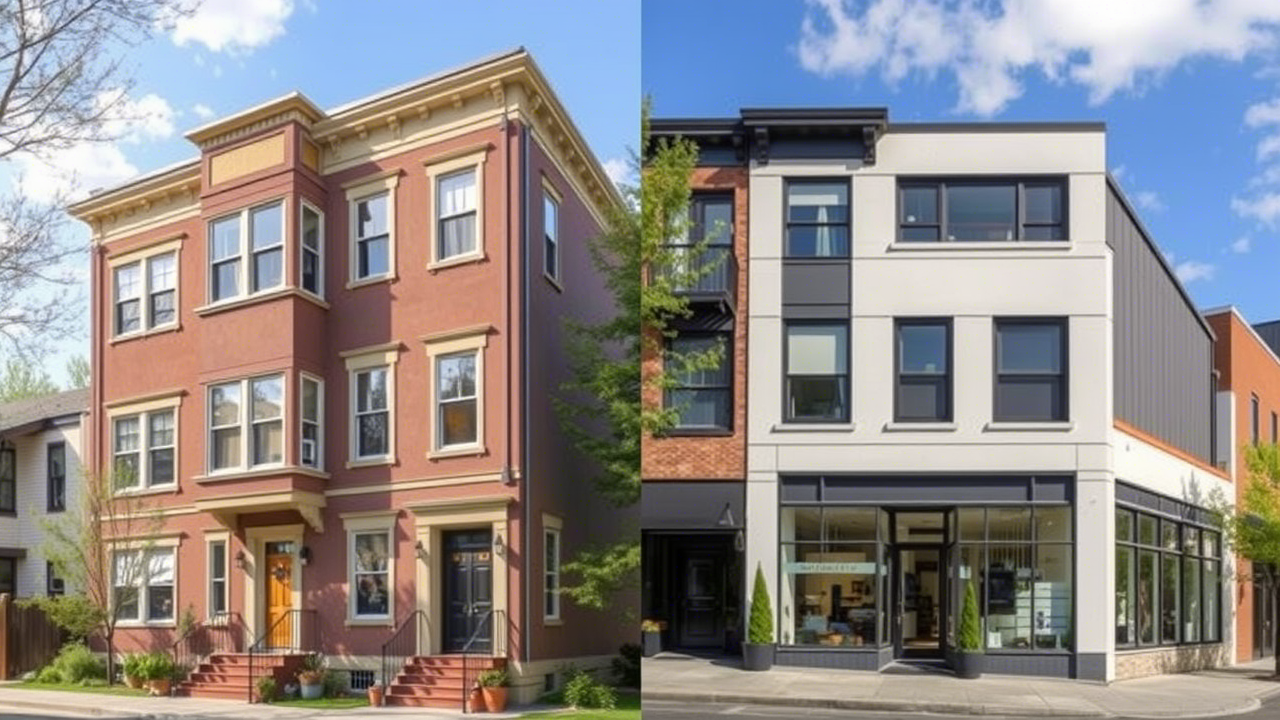
Choosing between residential and commercial real estate can feel like navigating a maze. Both offer unique opportunities and challenges, but how do you decide which aligns with your financial goals? Whether you’re a seasoned investor or a first-time buyer, understanding the nuances of residential vs commercial property is critical. This guide breaks down key differences, market trends, and strategies to help you maximize returns.
1. Understanding Residential and Commercial Real Estate
Residential Property Characteristics
Residential real estate includes single-family homes, condos, townhouses, and multifamily units (duplexes, triplexes). These properties are primarily used for living purposes, with leases typically lasting 12 months. Key traits:
- Tenant Relationships : Direct interaction with individuals or families.
- Lower Entry Costs : More affordable than commercial properties (average U.S. home price: $416,000 in 2023).
- Emotional Appeal : Buyers often prioritize location, aesthetics, and community.
Commercial Real Estate Features
Commercial properties include offices, retail spaces, warehouses, and hotels. These are income-generating assets leased to businesses. Key traits:
- Longer Leases : 5–10 years with built-in rent escalations.
- Higher Income Potential : Triple-net (NNN) leases pass maintenance costs to tenants.
- Complex Management : Requires understanding zoning laws, tenant creditworthiness, and market cycles.
2. Key Differences Between Residential and Commercial Real Estate
Property Use Differences: Residential vs Commercial
- Purpose : Residential serves living needs; commercial focuses on business operations.
- Zoning Laws : Residential zones restrict business activities; commercial zones permit retail, industrial, or office use.
- Valuation Metrics : Residential relies on comparable sales; commercial uses capitalization rates (cap rates) and cash flow analysis.
Investment Differences: Residential vs Commercial Real Estate
- Risk Profiles : Residential is less volatile (demand for housing is constant); commercial is cyclical (e.g., retail downturns during recessions).
- Cash Flow : Residential offers steady monthly rent; commercial provides bulkier, less frequent payments.
- Exit Strategies : Residential properties sell faster; commercial sales depend on market conditions and tenant stability.
Leasing vs Buying Real Estate
- Residential Leasing : Short-term, tenant-friendly laws (e.g., eviction protections).
- Commercial Leasing : Negotiated terms favor landlords, with clauses for rent increases and maintenance responsibilities.
3. Market Trends in Residential and Commercial Real Estate
Commercial vs Residential Market Trends (2023–2024)
- Residential Boom : Suburban and Sun Belt markets (e.g., Austin, Nashville) surged post-pandemic due to remote work.
- Commercial Shifts : Office spaces face high vacancy rates (18.7% in Q2 2023), while industrial real estate (warehouses, data centers) thrives due to e-commerce.
- Hybrid Models : Mixed-use developments combine residential and commercial spaces to meet evolving demands.
Emerging Sectors
- Build-to-Rent (BTR) : Single-family rentals grew 30% annually as homeownership becomes less accessible.
- Life Science Labs : Biotech hubs like Boston and San Diego see demand for specialized commercial spaces.
4. Investment Strategies for Residential and Commercial Properties
Residential Real Estate Strategies
- Buy-and-Hold : Purchase undervalued homes in up-and-coming neighborhoods for long-term appreciation.
- Vacation Rentals : Capitalize on platforms like Airbnb in tourist hotspots (e.g., Orlando, Maui).
- House Hacking : Live in one unit of a duplex and rent the other to offset mortgage costs.
Commercial Real Estate Strategies
- Value-Add Investments : Renovate outdated office buildings or retail spaces to boost rents.
- REITs : Invest in Real Estate Investment Trusts for diversified exposure without direct ownership.
- Ground Leases : Acquire land leased to businesses (e.g., cell towers, solar farms) for passive income.
Actionable Tips
- Residential : Focus on cash flow by targeting properties with rental yields above 8%.
- Commercial : Partner with experienced property managers to handle tenant relations and maintenance.
5. Pros and Cons of Residential vs Commercial Real Estate
| Factor | Residential | Commercial |
|---|---|---|
| Liquidity | Higher (easier to sell) | Lower (longer sales cycles) |
| Management | Hands-on (tenant turnover, repairs) | Hands-off (professional tenants) |
| Risk | Lower (stable demand) | Higher (economic sensitivity) |
| Financing | Easier (standard mortgages) | Complex (requires larger down payments) |
6. Case Studies: Success and Cautionary Tales
- Residential Success : A Phoenix investor bought a $300K duplex in 2020, now valued at $450K with $3,200/month rent.
- Commercial Caution : A retail plaza in Chicago lost 40% value after anchor tenants (e.g., Sears) filed bankruptcy.
7. How to Choose Between Residential and Commercial Real Estate
- Assess Risk Tolerance : Residential for stability; commercial for higher rewards.
- Capital Availability : Residential requires $100K–$500K; commercial often needs $1M+.
- Time Commitment : Residential demands active management; commercial relies on tenant reliability.
8. Future Outlook and Emerging Trends
- Residential : Modular homes and AI-driven property management tools will dominate.
- Commercial : Sustainability certifications (LEED) and smart warehouses (IoT integration) will rise.
- Tech Impact : Virtual reality tours and blockchain transactions will streamline both sectors.
Conclusion
The choice between residential vs commercial real estate hinges on your financial goals, risk appetite, and resources. Residential offers stability and lower barriers, while commercial promises scalability and higher returns. By aligning your strategy with market trends and leveraging data-backed insights, you can build a resilient portfolio.
Ready to invest? Start by analyzing local market reports or consulting a real estate advisor to refine your approach.



